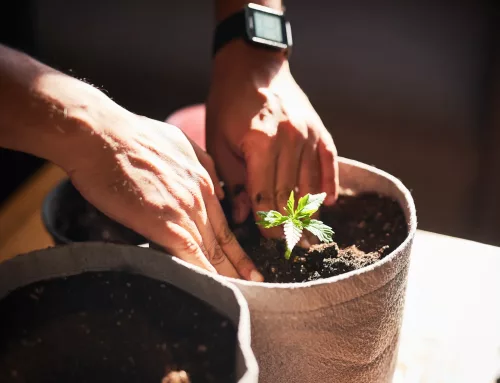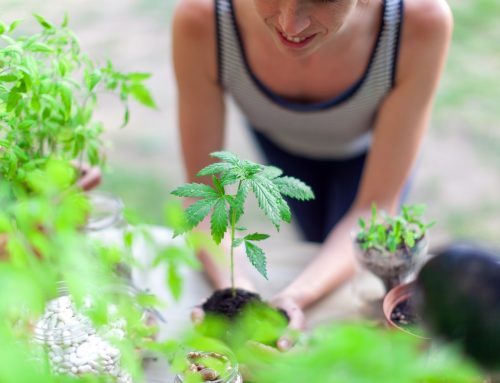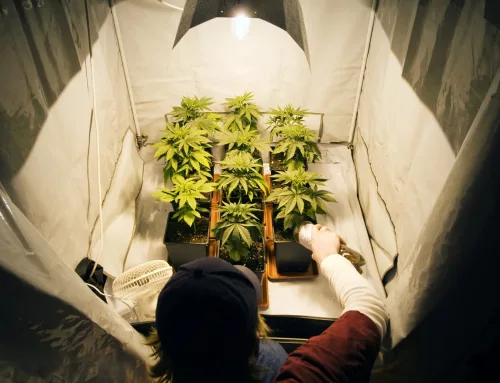The most common mistake growers make when watering their cannabis plants is over or underwatering.
Understanding how often to water cannabis plants, as well as how much water to give them at each feeding, is crucial for optimal growth and health.
Watering your cannabis plants is both an art and a science.
There are four factors to consider when determining the right frequency and amount of water for your cannabis plants, including temperature, humidity, age, and the size of your grow, as well as the growing environment itself.
This article delves into those critical factors, providing actionable guidance to optimize your watering practices for both indoor and outdoor cannabis cultivation.
4 Factors to Consider When Watering Cannabis Plants
If you’re wondering how often to water cannabis plants, you’re not alone.
When I started my first grow, this was the #1 question I would ask my mentors, immediately followed by “And how much should I water?”
The reason it’s hard to get a straight answer to how often you should water is because every plant and growing situation is different.
Considerations such as how often to water cannabis plants in summer vs. winter, how often to water outdoor cannabis plants rather than indoors, as well as the age and quantity of the plants you have will all impact your watering schedule.
Below, I’ll break down each of the 4 factors influencing your feeds, as well as offer some pro tips for adjusting your efforts as needed.
The Impact of Temperature on Watering Frequency
The temperature of your grow has a significant impact on your watering schedule.
Higher temperatures lead to increased evaporation from the soil and greater transpiration from the plant itself, often requiring more frequent, higher-volume feeds.
On the other hand, cooler temperatures slow down the evaporation process, allowing moisture to remain in the soil longer.
Pro Tip: Track temps in your grow. If you’re experiencing higher temperatures than normal, you can anticipate your plants’ needs and water more frequently and/or in higher amounts. If you notice temps dropping, scale back feeds to prevent oversaturation (waterlogging), which can lead to root rot, pythium, and other root zone threats.
Adjusting Cannabis Watering Schedule Based on Humidity
Relative humidity (RH) affects a plant’s performance, as well as its transpiration rate, which impacts how often you need to water your cannabis plants.
Transpiration is how a plant carries moisture from the roots to the leaves, where it changes to vapor and is released into the atmosphere. This is the plant’s way of releasing excess water to help cool the plant and draw nutrients from the soil. RH levels affect transpiration as well as how quickly moisture evaporates from the soil.
In environments with high humidity, the air is saturated with moisture, which prevents plants from releasing excess water vapor, leading to moisture buildup and slower feeding. As a result, plants require less frequent watering because the soil retains moisture for a longer period.
Conversely, low-humidity environments encourage excessive transpiration as the plant attempts to self-regulate its growing conditions by releasing more water into the air. This causes plants to lose water more rapidly, requiring more frequent watering.
Pro Tip: Monitor humidity levels using a hygrometer. If you notice abnormally high humidity levels, back off feeds for a day or two and allow the grow to stabilize. If humidity is dropping lower than normal, your plant may require additional feeds and/or misting, or the use of a humidifier. Adjusting your watering schedule based on humidity levels will help maintain optimal soil moisture and prevent stress on your plants.
The Influence of the Growing Environment on Watering Frequency
Where you are growing – indoors or outdoors – as well as when you’re growing – in the heat of summer or the dead of winter – significantly influences how often you need to water your cannabis plants. Outdoor grows are subject to the whims of nature’s weather conditions, which can greatly affect their watering needs.
If Mother Nature tosses a rainstorm at you once a week, you won’t need to water those days. On the other hand, dry, windy conditions may mean more frequent watering to prevent plants from getting thirsty when the soil dries out. Similarly, growers wondering how often to water cannabis plants in the summer will be met with larger volume, higher frequency recommendations and plants weather the higher temperatures and lower humidity of the season.
If you need to know how often to water cannabis plants indoors, on the other hand, they rely entirely on controlled conditions. . This allows for a more consistent and predictable watering schedule, which can be finely tuned according to the specific needs of the plants. However, even indoors, grows are affected by the seasons. In the summer, your air conditioning runs more than your heater, lowering temps but also impacting humidity. Similarly, heating your grow during the winter can dry out the air more than normal.
Pro Tips:
For outdoor cannabis plants, pay attention to the weather while monitoring the moisture in your soil or growing medium. If it is drying out by the time you come back for your next feed, it may benefit you to increase the amount per feed, or the frequency of feed. You can also utilize tools like mulch to help retain soil moisture during hot and dry periods.
For indoor cannabis plants, use tools like moisture meters to check soil moisture levels before watering. This can help you avoid overwatering, which also gives you a more precise measure of whether your current watering amounts and frequency are enough to maintain optimal plant health and prevent issues such as root rot or nutrient lockout.
Watering Based On Age & Amount of Plants
The age and amount of plants in your grow plays a decisive role in determining how often and how much you should water them. Seedlings and young plants have delicate root systems and are particularly susceptible to water stress, whether from too much or too little water, while mature flowering plants require more water to support the senescence they are undergoing as they bloom.
Additionally, 10 plants transpire more than a single plant, which means more moisture in the air, a higher humidity, and plants that may require less water than they would if grown individually.
When determining how often to water your cannabis seeds, the goal is to maintain a consistent moisture level around the roots without flooding the baby plant. I recommend using a fine mist sprayer or watering lightly with a syringe or measuring cup to avoid overwatering.
As your plants head into veg, they’ll need more water due to larger root systems and greater transpiration rates. During this time, you can allow the soil to “dry back” periodically to encourage root growth, but be careful not to create a completely dry, hydrophobic environment where roots struggle to survive.
Once you’re in flower, your cannabis plants will typically require the most water, and can handle deeper, less frequent waterings compared to seedlings.
In my grows, I try to have multiple plants per growing area to buffer my waterings with more transpiration. This allows me to water every other day for stable moisture regulation in my soil. If you’re growing in a different growing medium like coco or rockwool, your watering amounts and frequency may require feeding daily or multiple times per day.
Pro Tip: A good rule of thumb is to water 5-10% by container volume (so if you’re in a 5-gallon pot, watering 2000-4000ml per feed). Start baby seedlings in small pots, and transplant your way up to a final pot. This makes it easy to gradually ramp up the volume and frequency of feeds as your plants grow, without over watering because your pot is too big.
Water your cannabis plants like a pro
Watering cannabis effectively requires an understanding of how environmental factors and plant development stages affect hydration needs.
Track your grow’s conditions, and pay attention to changes that affect how often to water cannabis plants.
Adjusting your feeds based on your specific conditions will help you avoid the risks of over or under-watering. As you gain experience, you’ll become better at reading the signs your plants give you, making the process more intuitive and less formulaic. Remember, every plant is unique. Keep a close eye on your plants, and they’ll show you what they need to thrive.
GROW YOUR OWN TODAY
WITH HAPPY VALLEY GENETICS
Explore Feminized Autoflower and Photoperiod Seeds today!




